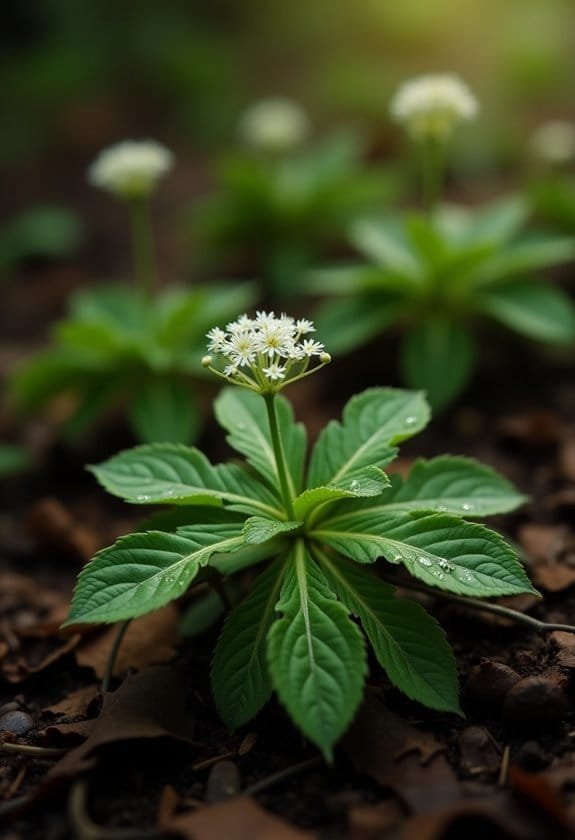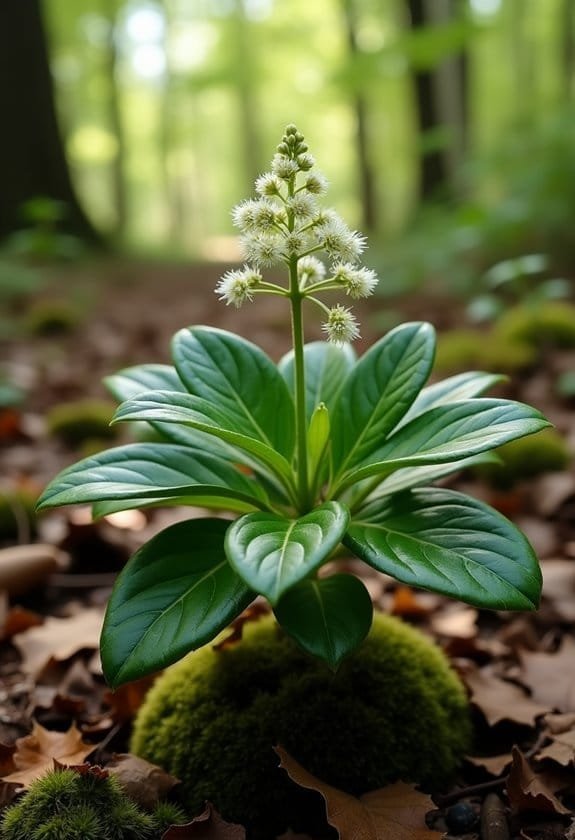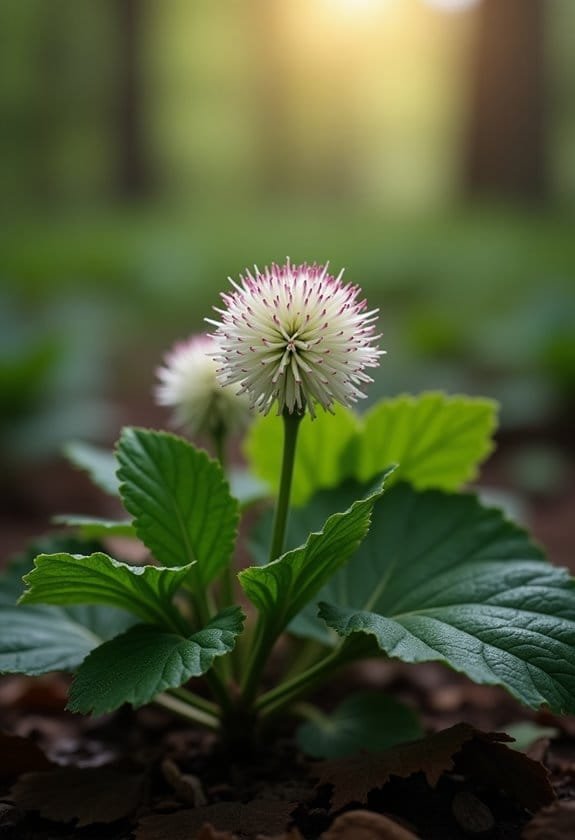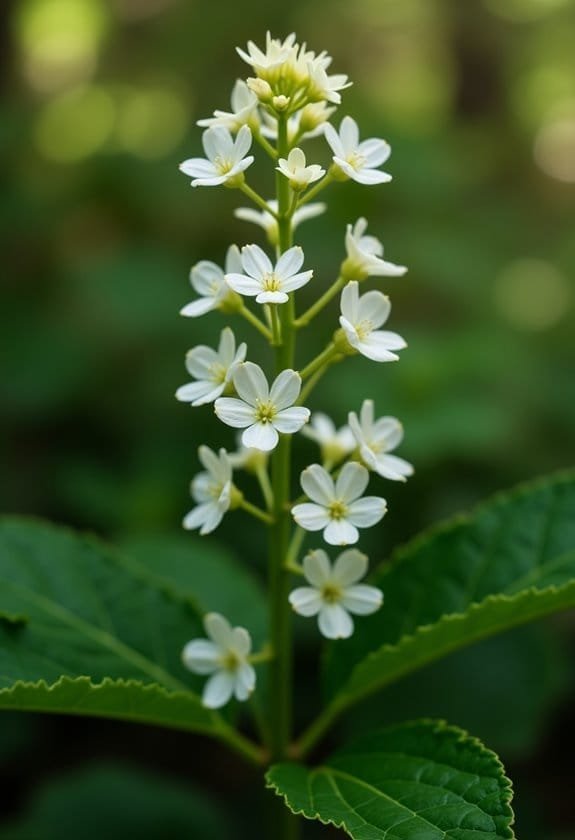Sanicula europaea, commonly known as Wood Sanicle, is a shade-loving perennial herb growing up to 60 centimeters tall in European woodlands. It's characterized by glossy, dark-green leaves with coarse teeth and distinctive pinkish flowers blooming in spherical umbels during late spring. The plant's name derives from Latin "sanare" (to heal), reflecting its traditional medicinal uses for wound healing and respiratory ailments. It thrives in partial to full shade within hardiness zones 5-9, requiring consistently moist, nutrient-rich loam soil with organic matter. Wood Sanicle's therapeutic potential and role in woodland ecosystems offer fascinating insights into this remarkable plant's significance.
Main Points
- Sanicula europaea is a medicinal woodland herb with glossy dark green leaves and pinkish flowers, belonging to the Apiaceae family.
- The plant grows up to 60 centimeters tall, thriving in partial to full shade with moist, nutrient-rich soil conditions.
- Traditional healing applications include wound treatment, respiratory ailments, and gastrointestinal issues, with proven antiviral properties against HPIV-2.
- Flowers bloom in spherical umbels from late spring to early summer, attracting pollinators and producing bristly fruits for seed dispersal.
- Regular monitoring and proper spacing of 2 feet between plants help prevent common issues like fungal infections and pest infestations.
Introduction

Sanicula europaea, commonly known as Wood Sanicle, stands as a remarkable medicinal herb in Europe's woodland flora.
The plant's distinctive appearance features glossy, dark green leaves with coarse teeth and delicate pinkish flowers arranged in spherical umbels, reaching heights of up to 60 centimeters.
This shade-loving perennial carries a rich heritage in traditional medicine, as reflected in its Latin-derived name "Sanicula," which speaks to its historical reputation for promoting health and healing.
Common Name
The European Sanicle (Sanicula europaea) goes by several common names, including Wood Sanicle and Self-Heal. As a member of the Apiaceae family, this versatile plant has earned its multiple monikers through centuries of traditional use and geographic distribution across European woodlands.
The name "Sanicle" derives from the Latin word "sanare," meaning to heal or cure, reflecting its long-standing reputation in herbal remedies and traditional medicine. In various European languages, local variations of the name maintain this connection to healing properties, while "Wood Sanicle" specifically references its preferred habitat in shaded, wooded areas.
The designation "Self-Heal" stems from the plant's historical use as a medicinal herb believed to possess natural healing abilities, though this name is sometimes confused with Prunella vulgaris, another medicinal plant.
The scientific name, Sanicula europaea, formally established its European origins and healing associations within botanical nomenclature. These diverse common names collectively paint a picture of a plant deeply embedded in European botanical and medicinal traditions, characterized by its distinctive pinkish umbels and woodland habitat preferences.
Scientific Name
Known scientifically as Sanicula europaea, this woodland herb's taxonomic name perfectly encapsulates both its healing heritage and geographic origins. The genus name Sanicula derives from the Latin word "sanus," meaning healthy, which reflects the plant's significant role in traditional medicine throughout history.
As a member of the Apiaceae family, commonly known as the carrot family, Sanicula europaea shares characteristics with its familiar relatives while maintaining its distinct identity. The plant's scientific classification accurately describes its physical attributes, including its height of up to 60 centimeters and its distinctive pinkish flowers arranged in compact, spherical umbels. These features make it readily identifiable in woodland habitats where it naturally occurs.
The species epithet "europaea" references the plant's widespread distribution across European territories, where it flourishes in shaded areas with rich, moist soil conditions. This scientific nomenclature not only places Sanicula europaea within its proper taxonomic framework but also provides valuable insights into its preferred growing conditions and natural habitat preferences.
Overview
Deep within Europe's woodland havens, Wood Sanicle stands as a demonstration to nature's healing prowess. Sanicula europaea, reaching heights of up to 60 centimeters, showcases glossy, dark green leaves with distinctive lobed patterns and coarsely toothed margins that capture the eye of woodland wanderers.
This remarkable medicinal plant has woven itself into the fabric of traditional medicine, deriving its genus name from the Latin word "sanus," which aptly reflects its historical significance in promoting health and wellness.
While its delicate pinkish flowers cluster in spherical umbels, the plant's true value lies in its traditional uses for wound healing, bronchitis, and cough relief. In the sheltered understory of European forests, where rich, moist soil provides ideal growing conditions, Sanicle has quietly maintained its presence in herbal medicine.
Though contemporary research hasn't fully validated its antiviral properties and effectiveness against respiratory conditions, the plant's enduring legacy in traditional medicine continues to intrigue scientists and herbalists alike.
This suggests potential therapeutic applications that await scientific confirmation through rigorous study.
Key Features
Sanicula europaea stands as a notable woodland herb, reaching heights of up to 60 centimeters with its distinctive glossy, dark green leaves that feature prominent lobed patterns and coarsely toothed margins.
The plant's most striking characteristic appears during its flowering season, when clusters of small pinkish blooms form tight spherical umbels that distinguish it as a member of the Apiaceae family.
These flowers later develop into bristly fruits equipped with tiny hooks, enabling them to cling effectively to passing animals or clothing, which serves as the plant's primary dispersal mechanism.
Growth Size
This woodland herb reaches heights of up to 60 cm (2 feet), featuring distinctive glossy, dark green leaves with lobed and coarsely toothed edges. Sanicula europaea demonstrates remarkable adaptability in its growth pattern, thriving particularly well in the filtered light of forest understories where it can achieve peak development.
The plant's vertical growth is complemented by its spreading habit, with the dark foliage creating an attractive ground cover in suitable conditions. In its preferred habitat of shady woodland areas, the sanicle's growth is significantly vigorous when established in moist, nutrient-rich soil.
The plant's structure supports its characteristic pinkish flowers, which emerge in tight spherical umbels at the stem terminals.
What's particularly interesting about its growth pattern is how it has evolved to maximize seed dispersal through its bristly fruits. These specialized structures, positioned at an ideal height for contact with passing wildlife, promote effective propagation throughout its woodland habitat.
This growth strategy allows Sanicula europaea to maintain stable populations within its preferred ecological niches.
Appearance
A distinctive woodland herb, Sanicula europaea exhibits several striking features that set it apart from other forest flora. The plant commands attention with its impressive height of up to 60 centimeters, creating a notable presence among the woodland understory vegetation.
The leaves of Sanicula europaea are particularly eye-catching, forming a vibrant rosette of glossy, dark green foliage that stands out against the forest floor. These glabrous leaves feature coarse teeth along their edges and distinctive lobes, while their turgid nature gives them a fresh, succulent appearance that enhances their visual appeal in shaded environments.
The plant's floral display consists of compact, spherical umbels adorned with delicate pinkish flowers, creating an architectural contrast to the robust foliage below.
Perhaps most notable are the bristly fruits, which have evolved an effective dispersal mechanism by readily attaching to passing animals or clothing. This adaptation guarantees the plant's successful distribution throughout its woodland habitat, while adding an interesting textural element to its overall appearance.
Flowering Season
While the plant's distinctive appearance marks its presence in woodlands year-round, the flowering season brings new life to Sanicula europaea from late spring through early summer. During this vibrant period, the plant reaches its peak blooming phase in May and June, transforming woodland floors with clusters of delicate pinkish flowers.
The flowering stems of Sanicula europaea stretch upward to impressive heights of 60 centimeters, each supporting dense, spherical umbels that create miniature constellation-like formations throughout the woodland ecosystem. These tightly packed flower clusters serve as essential feeding stations for various pollinators, contributing to the intricate web of woodland biodiversity.
As the flowering season progresses into summer, the plant's reproductive strategy shifts toward seed dispersal. The flowers gradually transform into bristly fruits, which have evolved to attach themselves readily to passing animals or human clothing. This clever adaptation guarantees the plant's seeds are distributed effectively throughout its habitat, enabling new colonies to establish themselves in suitable locations across the woodland floor.
Growing Requirements

Sanicle thrives in partial to full shade conditions across hardiness zones 5-9, making it an excellent candidate for woodland gardens and shaded landscapes.
The plant requires consistently moist, nutrient-rich loam soil enriched with organic matter, particularly leaf mulch, which helps maintain ideal growing conditions throughout the season.
For successful cultivation, gardeners should maintain temperatures typical of woodland environments, provide adequate spacing of 2 feet between plants, and guarantee proper soil moisture without waterlogging the root system.
Light
The lighting requirements for Sanicula europaea align perfectly with its woodland nature, as the plant thrives best in part to full shade conditions. This preference for filtered light mirrors its natural habitat, where towering canopies create an ideal environment for understory growth.
In hardiness zones 5 through 9, Sanicula europaea demonstrates remarkable adaptability to varying light conditions, though it's vital to protect it from direct sunlight exposure. Like many woodland species, it has evolved to flourish beneath the dappled shadows of taller vegetation, where it can maintain proper moisture levels in its preferred moist, loamy soil.
When planning a garden layout, it's important to take into account the plant's light requirements alongside proper spacing needs. Positioning Sanicula europaea approximately 2 feet apart guarantees adequate air circulation while maintaining the shade patterns necessary for best growth.
Gardeners should carefully observe the daily light patterns in their intended planting area, selecting locations where trees or structures provide natural shade throughout the majority of the day.
Soil
Beneath the woodland canopy, Sanicula europaea flourishes in moist, rich loam soil that mimics its natural forest environment. This woodland plant thrives in soil conditions that maintain consistent moisture levels while providing essential nutrients through decomposed organic matter.
The ideal growing medium combines well-draining loam with abundant leaf mulch, creating a balanced environment that retains moisture without becoming waterlogged. Much like its native woodland habitat, the soil should remain sheltered in shade, which helps maintain the suitable moisture balance that Sanicle requires for healthy growth.
Proper drainage plays a vital role in the plant's success, as saturated soil can lead to root deterioration and eventual plant failure. The incorporation of organic matter, particularly leaf mold and decomposed woodland debris, enriches the soil structure while supporting beneficial microbial activity.
These soil conditions closely replicate the plant's natural habitat, where generations of fallen leaves have created deep, nutrient-rich layers of humus beneath the forest canopy, providing the perfect growing medium for this woodland species.
Water
Moisture plays an essential role in cultivating Sanicula europaea, as this woodland herb demands consistent watering to replicate its natural forest habitat. The plant's affinity for moist soil necessitates regular watering, particularly during periods of drought when natural precipitation proves insufficient.
Growing in rich loamy soil enhances the plant's ability to retain significant moisture while simultaneously providing necessary nutrients for robust development. The soil's composition works in concert with consistent humidity levels, creating an environment that mirrors the plant's native woodland setting.
To maintain ideal growing conditions, adequate drainage must be implemented to prevent water stagnation, which could potentially compromise root health and overall vigor.
Proper water management directly influences the plant's medicinal properties, making it essential to strike the right balance in moisture levels. Gardeners should monitor soil dampness regularly, ensuring the substrate remains consistently moist but never waterlogged.
This careful attention to hydration helps maintain the plant's therapeutic potential while supporting its natural growth patterns, much like the delicate moisture balance found in its indigenous woodland habitat.
Temperature
Successfully cultivating Sanicula europaea requires careful attention to temperature conditions, as this woodland herb flourishes within hardiness zones 5 to 9. This resilient plant can withstand temperatures ranging from -20°F to 20°F (-29°C to -6°C), though it performs best in consistently cool environments.
In its natural habitat, Sanicula europaea thrives in shady woodland settings where temperatures remain moderate throughout the growing season. The plant's preference for part to full shade helps maintain the cool, moist conditions essential for ideal growth, particularly when planted in rich loam soil that regulates temperature effectively.
Spring and fall provide perfect growing temperatures for this species, as these seasons mirror its native woodland climate. During summer months, protection from excessive heat becomes vital for maintaining plant health.
Gardeners should monitor temperature fluctuations carefully, as extreme heat can stress the plant and impede its development. Creating a microclimate that mimics its natural woodland environment, through strategic placement in shaded areas and proper soil preparation, helps guarantee the plant maintains its preferred temperature range throughout the growing season.
Pollinator Criteria
Sanicula europaea's pinkish flowers cluster into dense spherical umbels that act as natural landing pads for various pollinating insects.
The plant's strategic flowering period during late spring to early summer aligns perfectly with peak pollinator activity, especially attracting bees and other beneficial insects to its woodland habitat.
These pollinators navigate through the shaded understory, where Sanicle's distinctive flower formations provide essential nectar resources while facilitating cross-pollination among plant populations.
Attracted Pollinators
The tight spherical umbels of pinkish flowers make Sanicula europaea highly attractive to various pollinators, particularly bees and butterflies. During the critical late spring to early summer blooming period, these woodland plants serve as essential nectar sources for diverse pollinator populations seeking sustenance.
The plant's glabrous flower structure creates an ideal landing platform for visiting pollinators, facilitating efficient pollen transfer between different specimens. In shaded woodland environments, where Sanicula europaea typically thrives, the flowers provide a reliable food source for pollinators that prefer foraging in less exposed conditions.
The plant's strategic positioning within these sheltered habitats makes it particularly valuable for shade-tolerant pollinator species.
Furthermore, Sanicula europaea's integration with surrounding woodland flora enhances overall ecosystem biodiversity. This collaborative relationship between the plant and its companion species creates a more robust habitat network, supporting a wider range of pollinator populations throughout the growing season.
The result is a self-sustaining cycle where pollinators guarantee the plant's reproduction while benefiting from its consistent nectar supply.
Pollination Method
Primary pollination of Sanicula europaea relies on cross-pollination through insect vectors, with bees serving as the most efficient pollinators due to their systematic foraging behavior. The plant's distinctive pinkish flowers, arranged in tight spherical umbels, create an accessible platform for visiting insects to collect nectar and transfer pollen.
During the peak flowering season, the pollination process intensifies as various insects navigate between the compact flower clusters. The structure of Sanicula europaea's flowers has evolved to maximize successful pollination, featuring an arrangement that guarantees pollinators make contact with both male and female reproductive parts.
This intricate relationship between the plant and its pollinators contributes considerably to woodland habitats' biodiversity, forming part of a complex ecological network.
Once pollination is complete, the plant develops bristly fruits adapted for animal-mediated seed dispersal, guaranteeing the next generation's distribution throughout the ecosystem.
This dual mechanism of insect pollination followed by animal dispersal demonstrates Sanicula europaea's sophisticated reproductive strategy, which has evolved to maintain stable populations within its natural woodland environment.
Care & Maintenance

Successful cultivation of Sanicula europaea starts with proper planting in rich, loamy soil enhanced with leaf mulch, maintaining consistent 2-foot spacing between specimens.
The plant's ongoing care requires vigilant moisture management and periodic mulch replenishment, particularly during drier periods when the soil might need additional water to maintain its preferred damp conditions.
While sanicle thrives independently, it pairs exceptionally well with other shade-loving woodland plants such as ferns and wild ginger, which share similar growing requirements and create a harmonious forest-floor community.
Planting Tips
Proper planting and maintenance of Sanicula europaea starts with selecting the right location in hardiness zones 5 to 9. This woodland plant thrives best in areas that receive part to full shade, making it an excellent choice for understory plantings or shaded garden borders.
When preparing the planting site, incorporate plenty of organic matter to create a moist, rich loamy soil environment that mimics the plant's natural habitat. Gardeners should space seedlings approximately 2 feet apart to guarantee proper air circulation and allow room for mature growth.
For ideal germination success, seeds benefit from cold stratification, which can be achieved naturally by sowing in fall or artificially through pre-treatment methods. The timing of planting plays an essential role in establishment success. Fall planting allows seeds to undergo natural stratification during winter, while early spring planting works well for pre-treated seeds.
In woodland gardens, supplement the soil with leaf mulch to maintain consistent moisture levels and create conditions that mirror the plant's native environment. Regular moisture monitoring guarantees successful establishment, particularly during the first growing season.
Ongoing Care
The ongoing maintenance of Sanicula europaea focuses on consistent moisture management and seasonal mulching. The plant's success depends heavily on maintaining proper soil moisture levels throughout its growing season, particularly during dry spells when supplemental watering may become necessary.
Regular mulching with fallen leaves serves multiple purposes in Sanicula europaea care, as it helps retain essential soil moisture while simultaneously enriching the growing medium with organic matter.
While the plant thrives in part to full shade conditions, it's vital to monitor the density of overhead canopy to guarantee adequate filtered light reaches the foliage. Proper spacing between plants, maintaining approximately 2 feet of separation, remains important even after establishment to prevent overcrowding and foster healthy growth.
During the plant's dormant period, it's beneficial to refresh the mulch layer while being careful not to bury the crown.
Gardeners should resist the urge to remove fallen leaves entirely, as this natural debris contributes to the woodland environment that Sanicula europaea prefers, creating a self-sustaining cycle of nutrient replenishment that mirrors its native habitat.
Suggested Companions
Woodland companions play a crucial role in creating an ideal growing environment for Sanicula europaea. This shade-loving plant thrives when surrounded by complementary species that share its affinity for dappled light and moist soil conditions, particularly ferns and native wildflowers that contribute to a robust forest ecosystem.
When planning companion plantings, Prunella vulgaris stands out as an excellent partner for Sanicula europaea, as both medicinal plants prefer similar growing conditions and can enhance each other's therapeutic properties.
The key to successful companionship lies in maintaining proper spacing, with plants positioned approximately 2 feet apart to guarantee adequate air circulation and resource distribution. A carefully planned understory community, enriched with leaf mulch, creates a supportive microclimate that benefits all participating species.
Gardeners should monitor the entire plant community for signs of pest activity, as the health of companion plants directly impacts Sanicula's liveliness. By selecting appropriate shade-loving companions and maintaining ideal growing conditions, gardeners can establish a thriving woodland garden that showcases Sanicula europaea while supporting a diverse array of complementary species.
What Are the Differences Between Alexanders and Sanicle in Terms of Medicinal or Edible Uses?
Alexanders and sanicle differ significantly in their uses. Alexanders plant historical uses include treatments for digestive issues and its role as a versatile wild vegetable in ancient cuisines. In contrast, sanicle is prized for its wound-healing and astringent properties, often used in poultices and teas for traditional medicinal purposes.
Common Issues
Sanicle plants commonly face challenges with fungal infections, particularly powdery mildew and leaf spot diseases that manifest as discolored patches on foliage.
Root rot can emerge in poorly-draining soils, while aphids and spider mites occasionally target the plant's tender growth, causing leaf distortion and reduced vigor.
Effective management includes improving air circulation, adjusting watering practices to prevent soil saturation, and utilizing organic pest controls such as neem oil or insecticidal soaps when infestations occur.
Pests/Diseases
While generally resistant to most issues, European sanicle can fall prey to several common woodland pests and diseases. The Sanicula europaea plant most frequently encounters problems with aphids and slugs, which can damage its foliage and impede growth if left unchecked.
In particularly damp conditions, fungal diseases pose a significant threat to the plant's health, with powdery mildew being especially problematic in shaded areas where air movement is restricted. This fungal infection manifests as a white, powder-like coating on leaves and stems, potentially compromising the plant's vigor and aesthetic appeal.
Fortunately, several preventive measures and treatment options exist for managing these challenges. Maintaining proper spacing between plants creates essential air circulation, reducing the likelihood of fungal diseases taking hold.
Regular monitoring allows gardeners to spot early warning signs, such as yellowing leaves or unusual growth patterns, enabling timely intervention. When treatment becomes necessary, organic pest control methods, including beneficial insect introduction and neem oil applications, offer environmentally conscious solutions that effectively address most pest and disease issues.
Solutions
Several effective solutions exist for managing common issues that affect Sanicula europaea plants. When cultivating this woodland species, maintaining proper shade and soil moisture levels helps prevent many common growing problems, while ensuring adequate drainage prevents root rot and fungal infections.
For plants affected by respiratory issues or showing signs of viral infection, extracting the plant's natural antiviral compounds has proven beneficial, particularly against HPIV-2 viruses. The plant's medicinal properties can be enhanced by harvesting leaves during peak growing seasons and properly processing them for therapeutic use.
While Sanicula europaea offers solutions for various gastrointestinal ailments, careful consideration must be given to patients with existing digestive tract problems, as the plant's potent compounds may require dosage adjustments.
To address cultivation challenges in non-native environments, creating artificial woodland conditions with proper soil composition and shade structures can help maintain ideal growing conditions.
Regular monitoring of soil pH and moisture levels, combined with strategic companion planting, helps maintain the plant's health while maximizing its therapeutic potential.
Summary

Throughout the woodlands of Europe grows Sanicula europaea, a medicinal plant known for its healing properties and distinctive dark green foliage. This remarkable herb, reaching heights of up to 60 centimeters, has earned its reputation through centuries of traditional therapeutic applications, particularly in wound healing and treating respiratory ailments.
The plant's Latin name, derived from "sanus," meaning healthy, reflects its significant role in historical medicine and modern scientific interest, especially regarding its antiviral properties against HPIV-2. While research suggests Sanicula europaea is possibly safe for oral consumption in moderate amounts, individuals with digestive issues should exercise caution when considering its use.
Growing primarily in shaded areas with rich, moist soil conditions, this woodland herb displays glossy, coarsely toothed leaves and produces delicate pinkish flowers arranged in spherical umbels.
Though traditional healers have long valued Sanicle for treating coughs and bronchitis, current scientific evidence supporting these applications remains limited, and further research is needed to fully understand its therapeutic potential, particularly during pregnancy and breastfeeding.


